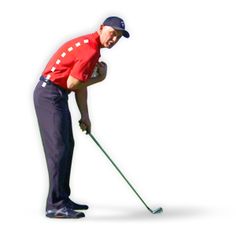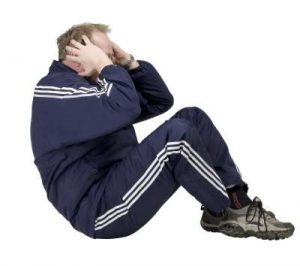Are all core exercises created equally?
It’s well documented that core strength is critical to prevent injury and improve the golf swing. When I evaluate a golfer new to golf fitness, I often hear that he or she already does core strengthening. My first question is always, “what do you mean, core strengthening?” Too often the response is, “Oh well you know, crunches, the ab machine where you press your chest down, things like that.” After full evaluation, 9 times out of 10 this individual has poor spine and hip stability, poor posture, and swing flaws associated with both.

Pick The Right Exercises!
When picking exercises for core strength, make sure you choose exercises that will improve body function in whatever activity you partake in. Crunches and abdominal exercise machines are likely to be the wrong choice for golfers.
The crunch and ab machines usually promote upper spine flexion (bending). This rounds the shoulders and puts the back into a humped position. As a golfer, this is not a position you want to be training in.
Excessive upper spine flexion and shoulder rounding promotes poor posture, bad rotation and flaws in the golf swing. In addition, crunches and other ab exercises that require you flex from the shoulders down to the hips can put a lot of stress in the neck and low (lumbar) spine. If you’re looking to improve your golf swing, look for alternatives to this type of exercise

Exercises to get you started:
Dead Bugs
For beginners, core strengthening should focus on holding positions that promote anti-extension (arching) of the low back. One simple yet effective exercise that does this is called the dead-bug exercise. With this exercise make sure you keep your abs braced and your low back flat and pressed into the floor. Perform 2-4 sets x 20 reps before your workouts or golf as a great way to activate the core. This can be done without a stability ball if you don’t own one.
[youtube https://www.youtube.com/watch?v=RXGDQ4C7ieU]
Prone Plank
For intermediates, the classic exercise called plank is a great way you can challenge yourself. To execute a proper plank, start by laying face down on the floor. Position your elbows directly under your shoulders and make sure your toes and feet are flexed and curled up toward the shins. Before you lift into the plank position, contract both your abs and glutes, and make sure your knees are locked out. From here, lift your body off the floor and hold as long as possible. It is very important that you can maintain contraction of both the abs and glutes throughout the set. If you are unable to keep the abs and glutes engaged, lower yourself and take a rest before your next set. Perform 2-4 sets to the point of fatigue (but not to failure), during your workouts or before golf.

I must stress that golf fitness usually does not look like traditional fitness. If you are unsure whether or not your current fitness routine is helping your golf game, I suggest you find a TPI (Titleist Performance Institute) Certified Golf Fitness Professional in your area for an assessment. If you have any questions about golf fitness, please feel free to email me at [email protected].
Jason Rivkin, CGFI-FP1, TPI Certified, Golf Fitness Coach
If you try these exercises and you find them to be too challenging or uncomfortable, do not continue, until you have consulted with your physician. All exercises for golf should be customized to your needs after a proper evaluation.
Come In and See Us
Want to take your golf to the next level? Our FitGolf® Trainers are experts at working one-on-one with you to tailor a training program to meet the specific needs of your body and help you achieve the results you are hoping to see in your golf.
Want More Resources?
Looking for more exercise resources, blog posts or monthly golf-specific exercise content sent straight to your inbox?
